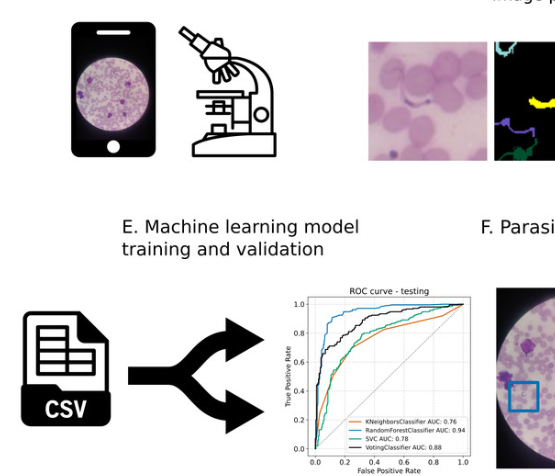Automatic detection of the parasite Trypanosoma cruzi in blood smears using a machine learning approach applied to mobile phone images
Chagas disease is a life-threatening illness caused by the parasite Trypanosoma cruzi. The diagnosis of the acute form of the disease is performed by trained microscopists who detect parasites in blood smear samples. Since this method requires a dedicated high-resolution camera system attached to the microscope, the diagnostic method is more expensive and often prohibitive for low-income settings. Here, we present a machine learning approach based on a random forest (RF) algorithm for the detection and counting of T. cruzi trypomastigotes in mobile phone images. We analyzed micrographs of blood smear samples that were acquired using a mobile device camera capable of capturing images in a resolution of 12 megapixels. We extracted a set of features that describe morphometric parameters (geometry and curvature), as well as color, and texture measurements of 1,314 parasites. The features were divided into train and test sets (4:1) and classified using the RF algorithm. The values of precision, sensitivity, and area under the receiver operating characteristic (ROC) curve of the proposed method were 87.6%, 90.5%, and 0.942, respectively. Automating image analysis acquired with a mobile device is a viable alternative for reducing costs and gaining efficiency in the use of the optical microscope.
Authors
Morais, Mauro Cesar Cafundo; Silva, Diogo; Milagre, Matheus Marques; de Oliveira, Maykon Tavares; Pereira, Thais; Silva, Joi£o Santana; Costa, Luciano da F; Minoprio, Paola; Junior, Roberto Marcondes Cesar; Gazzinelli, Ricardo;
External link
Publication Year
Publication Journal
Associeted Project
User-friendly computational Tools
Lista de serviços
-
StructRNAfinder: an automated pipeline and web server for RNA families prediction.StructRNAfinder: an automated pipeline and web server for RNA families prediction.
-
CEMiTool: a Bioconductor package for performing comprehensive modular co-expression analyses.CEMiTool: a Bioconductor package for performing comprehensive modular co-expression analyses.
-
webCEMiTool: Co-expression Modular Analysis Made Easy.webCEMiTool: Co-expression Modular Analysis Made Easy.
-
Assessing the Impact of Sample Heterogeneity on Transcriptome Analysis of Human Diseases Using MDP Webtool.Assessing the Impact of Sample Heterogeneity on Transcriptome Analysis of Human Diseases Using MDP Webtool.
-
Predicting RNA Families in Nucleotide Sequences Using StructRNAfinder.Predicting RNA Families in Nucleotide Sequences Using StructRNAfinder.
-
OUTBREAK: a user-friendly georeferencing online tool for disease surveillance.OUTBREAK: a user-friendly georeferencing online tool for disease surveillance.
-
Noninvasive prenatal paternity determination using microhaplotypes: a pilot study.Noninvasive prenatal paternity determination using microhaplotypes: a pilot study.
-
Editorial: User-Friendly Tools Applied to Genetics or Systems Biology.Editorial: User-Friendly Tools Applied to Genetics or Systems Biology.
-
Automatic detection of the parasite Trypanosoma cruzi in blood smears using a machine learning approach applied to mobile phone imagesAutomatic detection of the parasite Trypanosoma cruzi in blood smears using a machine learning approach applied to mobile phone images
-
Tucuxi-BLAST: Enabling fast and accurate record linkage of large-scale health-related administrative databases through a DNA-encoded approachTucuxi-BLAST: Enabling fast and accurate record linkage of large-scale health-related administrative databases through a DNA-encoded approach
-
Ten quick tips for harnessing the power of ChatGPT in computational biologyTen quick tips for harnessing the power of ChatGPT in computational biology

